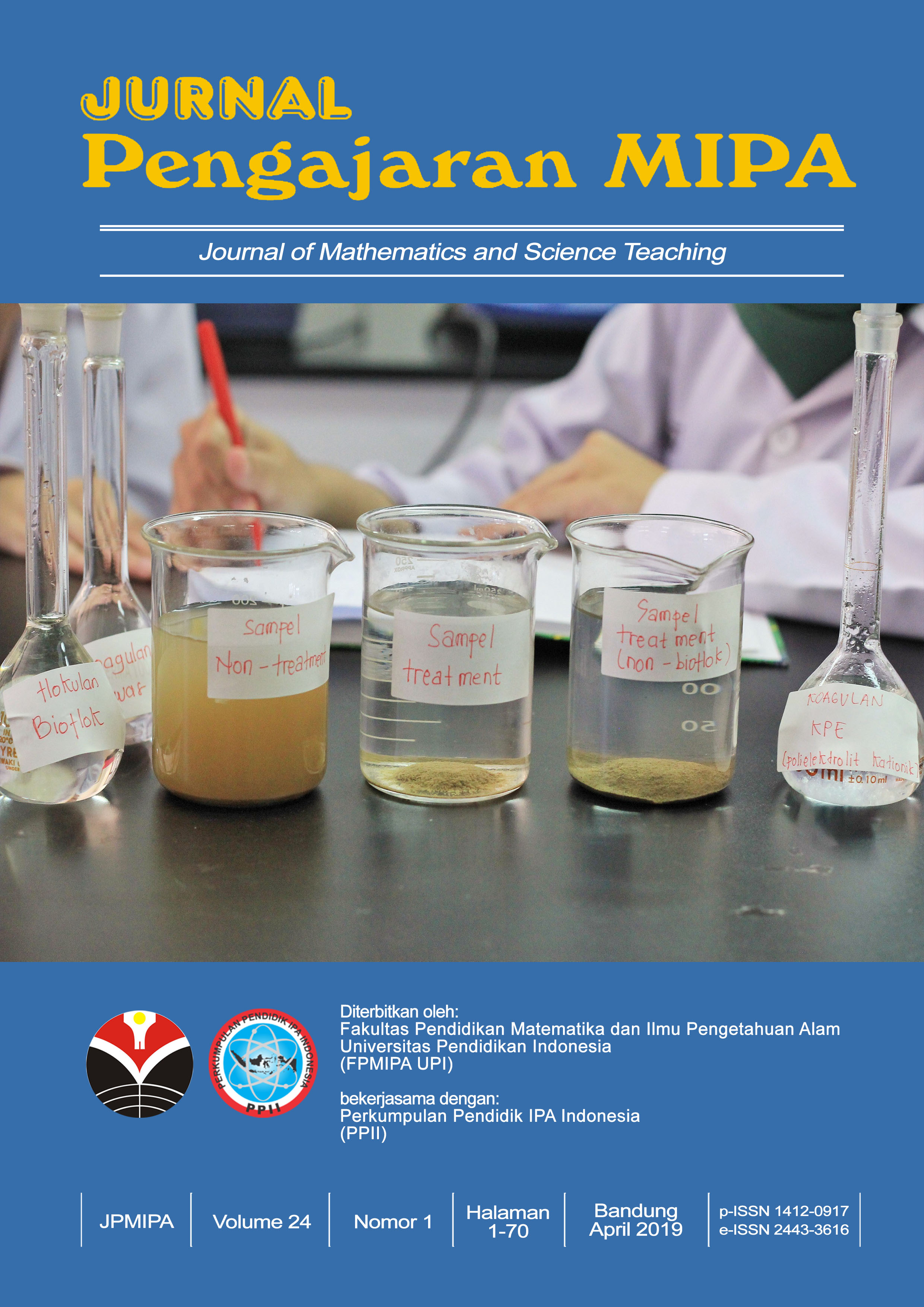IMPROVING PRESERVICE BIOLOGY TEACHERS’ SPATIAL THINKING IN PLANT ANATOMY COURSE THROUGH FRAMING
Abstract
In this study, we reported the implementation of framing in plant anatomy course and how framing improves preservice biology teachers' spatial thinking. Thirty-five preservice biology teachers served as subjects. Spatial thinking were evaluated based on four cognitive processes in spatial thinking: (1) producing representations, (2) maintaining and managing representations in working memory, (3) scanning the representation in working memory, and (4) transforming representations. Results indicated that framing improved preservice biology teachers’ spatial thinking in which all four spatial thinking parameters significantly improved after learning plant anatomy with framing. Framing in a plant anatomy course can improve preservice biology teachers’ spa-tial thinking because questions, guiding sentences, and worked examples aided them in overcoming cognitive stress when engaged in a difficult task.
ABSTRAK
Dalam studi ini, kami melaporkan implementasi framing dalam mata kuliah anatomi tumbuhan dan bagaimana framing dapat meningkatkan pemikiran spasial calon guru biologi. Tiga puluh lima calon guru biologi menjadi subjek penelitian ini. Keterampilan berpikir spasial dievaluasi berdasarkan empat proses kognitif dalam pemi-kiran spasial: (1) menghasilkan representasi, (2) mempertahankan dan mengelola representasi dalam working memory, (3) memindai representasi dalam working memory, dan (4) mentransformasikan representasi. Hasil penelitian menunjukkan bahwa framing meningkatkan pemikiran spasial calon guru biologi dengan keempat parameter berpikir spasial meningkat secara signifikan setelah pembelajaran anatomi tumbuhan dengan fra-ming. Framing dalam mata kuliah anatomi tumbuhan dapat meningkatkan pemikiran spasial calon guru bio-logi karena pertanyaan-pertanyaan, kalimat-kalimat panduan, serta worked examples membantu mereka dalam mengatasi stres kognitif saat terlibat dalam tugas yang sulit.
How to cite: Ermayanti, Rustaman, N.Y., & Rahmat, A. (2016). Improving Preservice Biology Teachers’ Spa-tial Thinking in Plant Anatomy Course through Framing. Jurnal Pengajaran MIPA, 21(2), 185-190.
Keywords
Full Text:
PDFReferences
Anderson, J. L., Ellis, J. P., & Jones, A. M. (2014). Understanding Early Elementary Children Conceptual Knowledge of Plant Structure and Function through Drawings. Cell Biology Education, 13(3), 375–386.
Autin, F. & Croizet, J. K. (2012). Improving working memory efficiency by reframing metacognitive interpretation of task dif-ficulty. Experimental Psychology, 141(4), 610-618.
Barclay, G. (2002). Plant Anatomy in Ency-clopedia of Life Sciences (page 1-14). Chichester: John Wiley & Sons, Ltd.
Barman, C.R., Stein, M., McNair, S., & Barman, N.S. (2006). Students’ Ideas about Plants & Plant Growth. The American Biology Teacher, 68(2), 73-79.
Berdnarz, R.S., & Berdnarz, S.W. (2008). The importance of spatial thinking in an un-certain world. D.Z. Sui (Eds.). Geospatial Technologies and Homeland Security(315-330). Dordrecht: Springer.
Berland, K. L. & Hammer, D. (2012). Framing for scientific argumentation. Research in Science Teaching, 49(1), 68-94.
Brodersen, C. R., & Roddy, A. B. (2015). New frontiers in the three-dimensional visual-ization of plant structure and function. A-merican Journal of Botany, 103(2), 184-188.
Engle, R.A. (2006) Framing Interactions to Foster Generative Learning: A Situative Explanation of Transfer in a Community of Learn-ers Classroom. Journal of the Learning Sciences, 15(4), 451-498.
Engle, R. A., Nguyen, P. D & Mendelson, A. (2011). The influence of framing on trans-fer: initial evidence from a tutoring experi-ment. Instructional Science, 39, 603-628.
Evert, R. F. (2006). Esau’s Plant Anatomy: Meri-stems, Cells, and Tissues of the Plant Bo-dy: Their Structure, Function, and Deve-lopment, Third Edition. New York: Wiley.
Ermayanti. Rustaman, N. Y. dan Rahmat, A. (2015). Profil praktikum anatomi tumbuh-an di LPTK (Field Study pada Praktikum Anatomi Tumbuhan di LPTK) dalam Pro-siding Seminar Pendidikan Biologi-IPA. Palembang: FKIP Unsri.
Hake, R.R. (1998). Interactive-engagement ver-sus traditional methods: A six-thousand-student survey of mechanics test data for introductory physics courses. American Journal of Physics, 66, 64-74.
Hoffler, T. N. (2010). Spatial ability: its influence on learning with visualization a meta-ana-lytic review. Education Psychology, 22, 245-269.
Hoyek, N., Collet, C., Rastello, O., Fargier, P., Thiriet, P., & Guillot, A. (2009). Enhance-ment of Mental Rotation Abilities and Its Effect on Anatomy Learning. Teaching and Learning in Medicine, 21(3), 201–206.
Injeong, J., & Bednarz, S.W. (2009). Evaluating Geography Textbook Questions from a Spatial Perspective: Using Concepts of Space, Tools of Representation, and Cog-nitive Processes to Evaluate Spatiality. Journal of Geography, 108(1), 4-13.
Kosslyn, S. M. (1978). Measuring the visual angle of the mind’s eye. Cognitive Psy-chology, 10, 356–389.
Lazarowitz, R. & Naim, R. (2013). Learning the cell structures with three-dimensional mo-dels: students achievement by methods, type of school and questions’ cognitive le-vel. Science Education Technology, 22, 500-508.
Lin, S-W. (2004). Development and Application of a Two-Tier Diagnostic Test for High School Students’ Understanding of Flo-wering Plant Growth and Development. International Journal of Science and Ma-thematics Education, 2, 175-199.
National Research Council. (2006). Learning to Think Spatially. Washington, D.C: The National Academies Press.
Rudall, P.J. (2007). Anatomy of Flowering Plants an Introduction to Structure and Develop-ment. New York: Cambridge University Press.
Russell-Gebbett, J. (1984) Pupils’ perceptions of three dimensional structures in biology lessons. Journal of Biological Education, 18(3), 220-226.
Suprapto, K. P., Rustaman, N. Y., Redjeki, S., & Rahmat, A. (2012). Implementasi Pem-belajaran Visuo spatial (3D) untuk Meng-embangkan Kemampuan Kognitif Calon Guru Biologi pada Konsep Anatomi Tumbuhan. Jurnal Pengajaran MIPA, 17, 46-52.
Vitharana, P.R.K.A. (2015). Student Misconcept-ions about Plant Transport-Sri Lankan Ex-ample. European Journal of Science and Mathematics Education, 3(3), 275-288.
Yenilmez, A., & Tekkaya, C. (2006). Enhancing Students’ Understanding of Photosynthe-sis and Respiration in Plant through Con-ceptual Change Approach. Journal of Sci-ence Education and Technology, 15(1), 81-87.
Zangori, L., & Forbes, C.T. (2016). Development of an Empirically Based Learning Perfor-mances Framework for Third-Grade Stu-dents Model-Based Explanations about Pl-ant Processes. Science Education, 100(6), 961–982.
DOI: https://doi.org/10.18269/jpmipa.v21i2.44271
Refbacks
- There are currently no refbacks.
Copyright (c) 2022 Jurnal Pengajaran MIPA

This work is licensed under a Creative Commons Attribution-ShareAlike 4.0 International License.
JPMIPA http://ejournal.upi.edu/index.php/jpmipa/index is licensed under a Creative Commons Attribution-ShareAlike 4.0 International License
Jurnal Pengajaran Matematika dan Ilmu Pengetahuan Alam (JPMIPA) or Journal of Mathematics and Science Teaching
All rights reserverd. pISSN 1412-0917 eISSN 2443-3616
Copyright © Faculty of Mathematics and Science Education (FPMIPA) Universitas Pendidikan Indonesia (UPI)
View JPMIPA Stats









